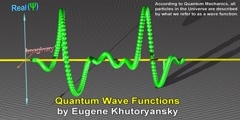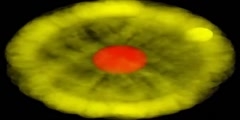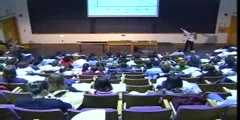Lec 8 - One-Dimensional Wave Functions
"Lec 8 - One-Dimensional Wave Functions" Freshman Organic Chemistry (CHEM 125) Professor McBride expands on the recently introduced concept of the wave function by illustrating the relationship of the magnitude of the curvature of the wave function to the kinetic energy of the system, as well as the relationship of the square of the wave function to the electron probability density. The requirement that the wave function not diverge in areas of negative kinetic energy leads to only certain energies being allowed, a property which is explored for the harmonic oscillator, Morse potential, and the Columbic potential. Consideration of the influence of mass reveals an "isotope effect" on dynamics, on the energy, vibration frequency, and length of bonds. 00:00 - Chapter 1. Review: The Curvature of the Wave Function and Kinetic Energy 06:44 - Chapter 2. Relationships between Nodes and Curvature of the Wave Function 23:49 - Chapter 3. The Square of Psi as the Probability Density 31:46 - Chapter 4. Constraints of Energy in the Harmonic Oscillator, the Morse Potential and the Coulombic Potential 42:12 - Chapter 5. The Influence of Mass on Bond Dynamics, Strength, and Distance Complete course materials are available at the Open Yale Courses website: http://open.yale.edu/courses This course was recorded in Fall 2008.
Video is embedded from external source so embedding is not available.
Video is embedded from external source so download is not available.
Channels: Chemistry (General)
Tags: Schrödinger equation wave function negative kinetic energy curvature nodes
Uploaded by: yalefreshorganic ( Send Message ) on 05-09-2012.
Duration: 49m 51s
Here is the next lecture for this course
Lec 7 - Quantum Mechanical Kinetic Energy
49:18 | 3293 viewsChemical Science - Matter As a Wave - Lec ...
44:24 | 14229 viewsQuantum wave functions
11:23 | 3879 viewsLec 59 - Wave Functions
07:46 | 2571 viewsLec 64 - P Wave Function (Quiz)
04:35 | 2634 viewsAtom wave functions
02:32 | 2551 viewsChemical Science - Hydrogen Atom Wavefunc ...
49:59 | 17969 viewsLec 4 - Wave Glider: An Autonomous Wave-P ...
01:09:24 | 3013 viewsTransfer of Energy by Wave
00:36 | 8563 viewsLec 12 - Determining the equation of a tr ...
09:51 | 2657 viewsA Lecture on P Orbitals
50:10 | 20363 viewsChemical Science - Hydrogen Atom - Lecture 6
47:24 | 23829 viewsChemical Science - Free Energy of Formati ...
47:47 | 17676 viewsLec 9 - Chladni Figures and One-Electron ...
49:36 | 2863 viewsStanding wave
07:18 | 9243 viewsNo content is added to this lecture.
This video is a part of a lecture series from of Yale
Lecture list for this course
Lec 2 - Force Laws, Lewis Structures and Resonance
Lec 3 - Double Minima, Earnshaw's Theorem and Plum-Puddings
Lec 4 - Coping with Smallness and Scanning Probe Microscopy
Lec 6 - Seeing Bonds by Electron Difference Density
Lec 7 - Quantum Mechanical Kinetic Energy
Lec 9 - Chladni Figures and One-Electron Atoms
Lec 10 - Reality and the Orbital Approximation
Lec 11 - Orbital Correction and Plum-Pudding Molecules
Lec 12 - Overlap and Atom-Pair Bonds
Lec 13 - Overlap and Energy-Match
Lec 14 - Checking Hybridization Theory with XH_3
Lec 15 - Chemical Reactivity: SOMO, HOMO, and LUMO
Lec 16 - Recognizing Functional Groups
Lec 17 - Reaction Analogies and Carbonyl Reactivity
Lec 18 - Amide, Carboxylic Acid and Alkyl Lithium
Lec 19 - Oxygen and the Chemical Revolution (Beginning to 1789)
Lec 20 - Rise of the Atomic Theory (1790-1805)
Lec 21 - Berzelius to Liebig and Wöhler (1805-1832)
Lec 22 - Radical and Type Theories (1832-1850)
Lec 23 - Valence Theory and Constitutional Structure (1858)
Lec 24 - Determining Chemical Structure by Isomer Counting (1869)
Lec 25 - Models in 3D Space (1869-1877); Optical Isomers
Lec 26 - Van't Hoff's Tetrahedral Carbon and Chirality
Lec 27 - Communicating Molecular Structure in Diagrams and Words
Lec 28 - Stereochemical Nomenclature; Racemization and Resolution
Lec 29 - Preparing Single Enantiomers and the Mechanism of Optical Rotation
Lec 30 - Esomeprazole as an Example of Drug Testing and Usage
Lec 31 - Preparing Single Enantiomers and Conformational Energy
Lec 32 - Stereotopicity and Baeyer Strain Theory
Lec 33 - Conformational Energy and Molecular Mechanics
Lec 34 - Sharpless Oxidation Catalysts and the Conformation of Cycloalkanes
Lec 35 - Understanding Molecular Structure and Energy through Standard Bonds
Lec 36 - Bond Energies, the Boltzmann Factor and Entropy
Lec Last - Potential Energy Surfaces, Transition State Theory and Reaction Mechanism















